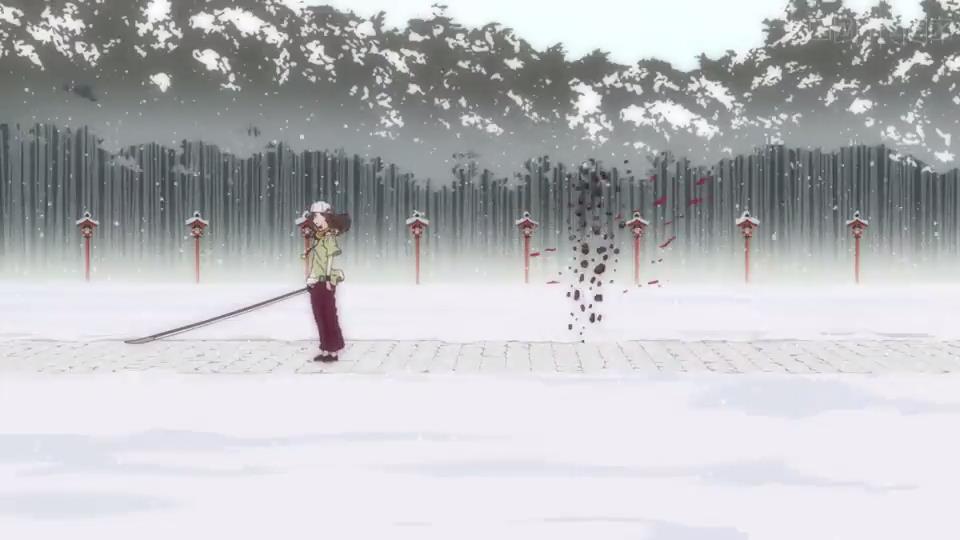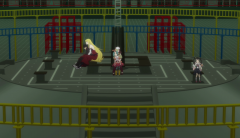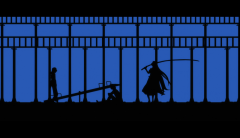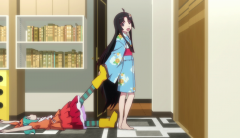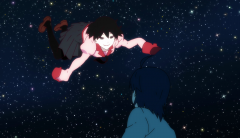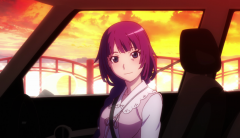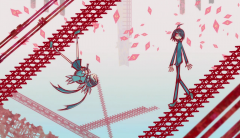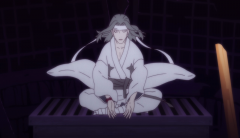Just a quick note that I originally intended this week’s review to be about Miss Hokusai. But because of the DVD release of this Kizumonogatari (with good subtitle to boost), I decided to bump this up and review it instead. Monogatari series has been among one of my favorite series, and certainly the one that I spend time the most. Sorry Miss Hokusai but you will have to wait for few weeks later. When it comes to Monogatari series there’s simply no competition, okay? Now, let begin.
It’s always a tricky line when you are making a TV movie when you think about it, because you have to please both the fans of the series, along with new audiences who never see the series before. In other words, you have to make a movie that maintains the elements, tone and themes that make the series famous, at the same time the movie has to have something that can stand on its own. In that regards I always consider that The Adolescent of Utena is the best TV movie adaptation ever in anime. The way it reimages the plot of the original show, updating the settings, altering some plot points, and then goes completely bananas with its theme. Kizumonogatari has a bit of advantage, since it is also based from the light novel as a prequel to Bakemonogatari. The film was originally announced to be adapted right after the first series, back in 2010. Six years past, with the presence of many following seasons, there were doubts whether or not Shaft going to adapt it at all. Then comes the announcement of not one film, but a trilogy. This movie is just the first part of the trilogy, and clocking at exactly 1 hour, the film doesn’t hide the fact that it’s not self-contained, instead the film pleases itself of placing a groundwork for more events to come in latter parts.
Kizumonogatari part 1 nails many of the show’s distinctive features. Audiences who already love the series will find a lot to enjoy here. There are long, snappy dialogues, the distinctive but messy style of visual, the sharp impressionist art backgrounds, the insert screen texts, the ecchi undertone and of course the head-tilts. They’re all here. Its quick styles of visual prove to be too much for some, but never fail to impress (there’s a reason that my avatar is from Monogatari). The color palate changes according to the mood the characters are in or the topics they conceive. Monogatari is one of the few examples on how a great adaptation should be, in the sense that they don’t need to adapt it faithfully, but take the tone, the theme of its source material and turn the show into a very distinct visual feast (The Tatami Galaxy is another example). After all, light novels and visual anime shows are two different mediums, there is something that work well in one medium but will not work in another, hence taking an artistic liberty to the source is a very necessary task. Many characters that we come to know and love has returned for the film, or to put it more correctly, appear for the first time together. It’s actually very nice to see those characters before everything happen, when they are still insecure and naïve.
Yet, this movie sets itself apart from the series for so many reasons, or I should say, this movie is an update version from the series. While usually I don’t like the use of narration, Monogatari series is one of the best example on how to use the voice-over right. Because every character in the show has their own distinctive voices, using narration to understand the way they think, the worldview they possess feels deeply personal. Yet in the movie, the inner voice is stripped down and what we have instead is the external experience. The film shows what the characters experience through pure visual storytelling instead of relying on what the character’s inner thought. The first sequence of the film is the perfect example of this approach to create a sense a paranoia we feel along with our main character Araragi. We literally follow our main character’s every footstep, see what he sees, hear what he hears. In the sequence, Araragi wanders around an abandoned building. He’s shaking and terrified, completely out of place. It is a nightmarish situation in which Araragi couldn’t get out of and we sense his uneasiness. All this were achieved without any spoken dialogue.
Moreover, if there is one element that truly stands out in the film, it is the sound designs. The film uses a more jazzy, popular melodic soundtrack that fits the scenes they play like a glove. My favorite piece of soundtrack happens when Hanekawa and Araragi meet up for the first time after the “incident”, the soundtrack goes Latino and sweet and upbeat, but later when Araragi encounters the vampire Kiss-Shot, the soundtrack goes dense and off-putting. The sound, or the lack thereof, complements the movie in so many way as well. I have to note that the sound designs, just like the visual presentation, are highly unconventional. The film use sounds like the tickling clock to represent the sexual tension of Araragi when he thinks back about Hanekawa’s underpants and big boobs, or use baby cries to substitute for the desperation of Kiss-shot when our main character refuse to help her, or the distorted sounds of people talking to illustrate the un-humanness Araragi is becoming. The more I think about those sound designs, the more I believe that the movie has outdone the series in so many level. The settings also get new designs: the old abandoned cram school, the high school and Araragi’s house have these new looks and it’s a joy to watch. As did with our characters. The characters have their own distinctive appearances and ask me which hairstyle fit Shinobu better, I would choose this one without hesitation. Unlike the series that I have mentioned earlier, the color palate in the film is dominated by the bright yellow and orange colors, which for me is very suitable, since Kiss-Shot has yellow hair (and she’s very important to this story), the yellow ray of the sun (which also very fitting with the theme) and most of all it makes the blood looks less terrified.
Story-wise, the film contains 3 parts: Araragi and Hanekawa meet for the first time; Araragi finds a limbless vampire Kiss-Shot on a verge of dying and decides to help her; Araragi on his mission to retrieve Kiss-Shot limbs in order to reverse back to human, with the help of Oshino Meme, a “negotiator”. Actually, for those of you who curious, the very first opening section of Bakemonogatari is basically a very quick overview of Kizumonogatari and contains the prequel’s most important scenes. Now I don’t encourage you to watch that to spoil yourself, but you might check it out to see the different in approach and design between that “preview” and the actual movie. That is for me what Kizumonogatari would look like if it were adapted 6 years ago. The second part of the film is easily the best part of the film, the way it mixes the natural world of the first part and the supernatural world of the last part, in addition with the visual and sound designs to create an eerie and quite disturbing atmosphere. Monogatari has tackled difficult and even depressing subjects before (the whole Sodachi’s acts), but this is the only time where they manage to put the viewers in and make sure us stay there with Araragi with an unflinching look.
So what’s to expect for the next two movies then? Oshino Meme mentioned that the whole thing now is too unbalanced that he can’t help but to step in; and he is the negotiator who bridges between here and there. Araragi thought that this is them (Araragi and Kiss-Shot – the Vampires) against human (the Vampire executors), but then Meme remarked again that Araragi and himself are human. If he can pick up something from that, he should have realized the reason Oshino Meme steps in is to help Araragi against Kiss-Shot. She’s hiding something and at this moment she just manipulates Araragi in order to get her full power back. Like the film states clearly in the beginning, “This story about a vampire has an unhappy ending – It concludes with everyone becoming miserable”. Don’t expect a joyous ending here, but that’s precisely the reason I look forward to the next movie.
Overall, Kizumonogatari part 1 is a worthy successor to the series, and a major step up in terms of production values and its visual storytelling, which is a feat itself consider that everyone have an extremely high expectation from it. Still, I have a hard time to score it alone as this one is clearly just a set up for more to come, but at least I could say that it succeeds in what it sets out to do. Lastly, to the question whether this movie would be a good place to start for newcomer. Well, I always prefer to go with the airing order, because they have been written that way (Kizumonogatari would be the third release in light novels). But I’d say the newcomer would welcome to watch this, because the movie both maintains many trademark elements from the series, and it’s chronically a beginning of its all. The only downside with this is you then have to wait for almost a year for the full trilogy to come out and it’s no fun waiting.
Next post, I will review one of my favorite film and personally the best animated film of this decade so fa… scratch that, this is one of the best film of this decade so far in any form, animated or not. Expect a high score here. Stay tune!
~SuperMario~
